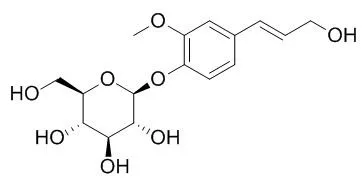| In vitro: |
| Plant Physiol. 1995 Feb;107(2):331-9. | | A beta-glucosidase from lodgepole pine xylem specific for the lignin precursor coniferin.[Pubmed: 7724669] | Coniferin, the glucoside of the monolignol coniferyl alcohol, accumulates to high levels in gymnosperms during spring-cambial reactivation. A cinnamyl alcohol glucoside/beta-glucosidase system is thought to play a key role in lignification by releasing the monolignol aglycones.
Investigation of such an enzyme system in the xylem of Pinus contorta var latifolia Engelm. revealed two major beta-glucosidases.
METHODS AND RESULTS:
One efficiently hydrolyzed the native substrate, Coniferin, and the other was more active against synthetic glucosides. The Coniferin beta-glucosidase was purified to apparent homogeneity using anion exchange, hydrophobic interaction, and size-exclusion chromatography. The apparent native molecular weight was estimated to be 60,000. A dominant 28-kD protein and a minor 24-kD protein were detected in the purified preparation following sodium dodecyl sulfate-polyacrylamide gel electrophoresis. Immunological evidence from polyclonal antibodies directed against the synthetic N-terminal peptide of the 24-kD protein suggested that the native protein is a dimer of 28-kD subunit size.
CONCLUSIONS:
The N-terminal sequence showed that Coniferin beta-glucosidase has high homology to known plant beta-glucosidases. Coniferin, syringin, and a synthetic Coniferin analog were preferred substrates for the Coniferin beta-glucosidase.
In situ localization using the chromogenic Coniferin analog showed the exclusive presence of beta-glucosidase activity in the differentiating xylem, similar to peroxidase activity. | | Journal of China Three Gorges University, 2009, 31(3):99-101. | | Study of Anti-oxidation Effects of Extracts of Balanophora Involucrate and Trans-Coniferin.[Reference: WebLink] |
METHODS AND RESULTS:
To study the anti-oxidation effect of extracts of Balanophora involucrate and trans-Coniferin,using the methods of DHHP to study the anti-oxidation effect of extracts of Balanophora involucrate and trans-Coniferin.When the concentration of the extracts of Balanophora involucrate is 3 mg/mL,the absorbency is the least;other concentrations can definitly eliminate the DPPH free radical.
CONCLUSIONS:
The conclusion is that both the extracts of the Balanophora involucrate and trans-Coniferin have anti-oxidation effects. | | New Phytol . 2014 May;202(3):823-837. | | Soluble phenylpropanoids are involved in the defense response of Arabidopsis against Verticillium longisporum[Pubmed: 24483326] | | Abstract
Verticillium longisporum is a soil-borne vascular pathogen causing economic loss in rape. Using the model plant Arabidopsis this study analyzed metabolic changes upon fungal infection in order to identify possible defense strategies of Brassicaceae against this fungus. Metabolite fingerprinting identified infection-induced metabolites derived from the phenylpropanoid pathway. Targeted analysis confirmed the accumulation of sinapoyl glucosides, Coniferin, syringin and lignans in leaves from early stages of infection on. At later stages, the amounts of amino acids increased. To test the contribution of the phenylpropanoid pathway, mutants in the pathway were analyzed. The sinapate-deficient mutant fah1-2 showed stronger infection symptoms than wild-type plants, which is most likely due to the lack of sinapoyl esters. Moreover, the Coniferin accumulating transgenic plant UGT72E2-OE was less susceptible. Consistently, sinapoyl glucose, coniferyl alcohol and Coniferin inhibited fungal growth and melanization in vitro, whereas sinapyl alcohol and syringin did not. The amount of lignin was not significantly altered supporting the notion that soluble derivatives of the phenylpropanoid pathway contribute to defense. These data show that soluble phenylpropanoids are important for the defense response of Arabidopsis against V. longisporum and that metabolite fingerprinting is a valuable tool to identify infection-relevant metabolic markers.
Keywords: Verticillium sp; coniferyl esters; infection markers; lignin; metabolite fingerprinting; phenylpropanoids; sinapate esters. |
|






 Cell. 2018 Jan 11;172(1-2):249-261.e12. doi: 10.1016/j.cell.2017.12.019.IF=36.216(2019)
Cell. 2018 Jan 11;172(1-2):249-261.e12. doi: 10.1016/j.cell.2017.12.019.IF=36.216(2019) Cell Metab. 2020 Mar 3;31(3):534-548.e5. doi: 10.1016/j.cmet.2020.01.002.IF=22.415(2019)
Cell Metab. 2020 Mar 3;31(3):534-548.e5. doi: 10.1016/j.cmet.2020.01.002.IF=22.415(2019) Mol Cell. 2017 Nov 16;68(4):673-685.e6. doi: 10.1016/j.molcel.2017.10.022.IF=14.548(2019)
Mol Cell. 2017 Nov 16;68(4):673-685.e6. doi: 10.1016/j.molcel.2017.10.022.IF=14.548(2019)